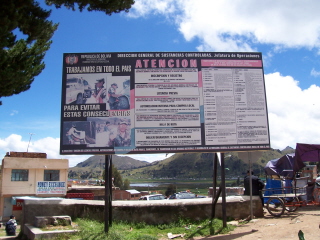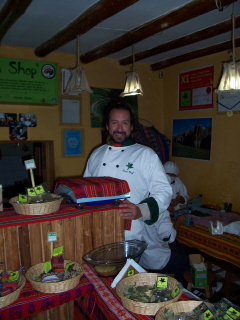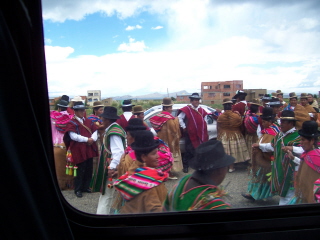On the long, arduous highway connecting Puno, the last major city in the Peruvian south, with the Bolivian capital of La Paz, travelers approaching Bolivia cross the border on the shores of Lake Titicaca near the small Bolivian town of Copacabana. There, the entrance to Bolivia is marked with a large billboard proclaiming Bolivia's intention to fight the traffic in cocaine and the precursor chemicals needed to transform coca into the popular stimulant drug. The billboard is a stark visual reminder that while Bolivian President Evo Morales, a former coca grower himself, has embarked on a policy of defending coca, his government has every intention of cracking down on the cocaine business.

The third largest producer of coca, from which cocaine is derived, Bolivia has for decades hewed to a policy of coca eradication directed from Washington, but it has paid a high price. In this decade, five presidents were driven from office in five years, at least in part because of simmering resentment over Bolivian obeisance to the US's "zero coca" policy. Prior to the election of Morales, eradication campaigns were accompanied by violent clashes, peasant rebellions, military and police violations of human rights, and numerous fatalities as successive governments sought to impose the will of the US on the country's impoverished coca growers.
"This has been a long-term negative approach," said Kathryn Ledebur of the Andean Information Network, (AIN) whose analyses of Bolivian coca politics inform much of this article. "The US needs to move away from just measuring the size of the coca crop or how much is eradicated and look at how this will play out in the next few years," she told Drug War Chronicle.
As a former coca grower union leader in the Chapare, Morales has the credibility with coca growers to enforce what is known as "cooperative eradication," as opposed to the forced eradication in pursuit of US policy aims that has engendered conflict and political instability in one of Latin America's poorest countries (average annual income under $1,000). While cooperative eradication began in the Chapare before Morales' election, it has gathered steam during his presidency, and in the last two years, Bolivia has seen the smallest increase in coca production of any of the Andean region's three big producers.
The other two major producers are Colombia and Peru. According to US estimates, coca production in Peru increased from 68,000 acres in 2004 to 95,000 acres in 2005, a 38% increase, while Colombian production increased from 285,000 acres to 360,000 acres, a 26% increase, despite widespread aerial fumigation of coca crops there. In Bolivia, on the other hand, the US estimated that production increased from 61,000 acres to 65,000 acres, an increase of only 8%. (The United Nations Office on Drugs and Crime, on the other hand, estimated an 8% decrease in Bolivian coca production during the same period, but both estimates are very close in terms of the actual size of the 2005 Bolivian crop.)
Overall, when looking at the regional coca production figures for the last five years, despite a US policy of aggressively seeking to eradicate coca, total coca production has increased in a step-wise fashion, rising from 125,000 acres overall in 2000 to nearly 500,000 thousand acres in 2005. This steady climb in overall coca production raises the question of whether any prohibition-based policy aimed at reducing production will achieve success as long as the global demand for cocaine continues to be high. Still, the Morales government is making what appears to be a good faith effort to both slow the rate of increase and appease the Americans.

That plan was to stay in place until the completion of a study to see how much coca is needed for legal markets, but that study has yet to be completed, and the agreement remains in effect. The majority of the reduction in coca production reported by the UN is now in the Chapare, and the violent conflict that plagued previous forced eradication efforts is now a thing of the past.
Despite the successful effort in the Chapare, US officials have continued to criticize the Morales government's coca policies. Last summer, US drug czar John Walters told reporters that Bolivia's "current level of [anti-drug] cooperation is not what it has been in the past, nor what it needs to be to continue reducing the problem." And just days earlier, a high-level USAID official, Adolfo Franco, testified before Congress that: "In Bolivia, Evo Morales and his Movement toward Socialism (MAS) party have continued to waver on economic policy, democracy and counternarcoticsâ¦"
The US has also been critical of an agreement between Morales and coca growers to de facto raise the legal limit from 30,000 acres to 50,000. US officials have criticized the agreement as allowing an increase in coca production. But as AIN's Ledebur told the Chronicle, "The idea that the increase in allowed production will lead to a real increase in production is mistaken. The increase merely accounts for coca that is actually being produced."
But the US Embassy in Bolivia has taken a slightly friendlier approach, one that recognizes the success in the Chapare. Last May, the month before Walters and Franco criticized Bolivia's coca policies, the embassy asked Bolivia to withdraw a US-funded police force from the Chapare, where it had been responsible for protecting eradicators and preventing the road blockades that had plagued the region in the past. The embassy has also publicly praised Morales' appointment of former Chapare coca grower Felipe Caceres as Bolivia's "drug czar" as an "excellent choice."
While the Morales government has adopted cooperative eradication in the Chapare and pro-coca policies that seek to increase legal markets for coca and recognize its positive attributes as part of Bolivian culture and as a food and medicine, it has also continued to work with US authorities in cocaine interdiction efforts and reported record levels of cocaine seizures last year.
Ironically, with the Chapare now essentially pacified, it is the Yungas region, home of the permitted legal cultivation, where problems are now arising. Coca production has expanded above the 30,000 acres allowed, and Bolivian government efforts to restrain the size of the crop have led to clashes between growers and the armed forces. Last May, the Morales government signed an agreement allowing growers in a part of the Yungas where production has been illegal to grow one cato per family, and negotiations are underway with growers in other parts of the Yungas.
But that agreement also called for a government task force to continue eradication efforts, and the first violent conflict with coca growers in two years occurred there in September, when two cocaleros were shot dead by members of a joint military-police eradication team during a conflict over eradication. The conflict had been simmering ever since last February when the task force entered the Vandiola Yungas after an agreement to eliminate coca in a national park there. But further negotiations about coca growing outside the park faltered, and in September the task force set up camps in the region. While local farmers allowed eradication to go inside the park, on September 29, they tried to block eradicators from entering what they considered a legitimate coca growing area, with the result that two farmers were killed.
Things have since cooled down somewhat in the Vandiola Yungas after an agreement allowing 650 families to grow 400 catos of coca, but tensions remain. Meanwhile, in the primary Yungas growing regions, there is increasing tension over efforts to curb cultivation there, which well exceeds the legal limit.

But the marketing of coca for legitimate medicinal and alimentary uses is still in its infancy, and Starbucks-like coca shops are still a glimmer in the eye of excited entrepreneurs. Still, the Morales government has substantially managed to put a lid on civil conflict around coca, has worked with the US government in interdiction efforts, and is undertaking real eradication campaigns. In that sense, Bolivian coca policy is working in a way it never has before. Will the US government recognize this, or will it continue to criticize Morales for allowing increases in production in some regions? Look for an answer to that question next month, when the annual certification report comes out.
In the meantime, Drug War Chronicle will be visiting the Chapare and, probably, the Yungas next week, as well as seeking a deeper understanding of the issues from analysts, growers, and Bolivian and US government officials. Stay tuned.
(Phil will be publishing several more from-the-scene reports over the coming weeks, during and after his stay. Read last week's report from Peru here and Phil's ongoing blog reports from the region here.)
This work by StoptheDrugWar.org is licensed under Creative Commons Attribution-ShareAlike 4.0 International
Comments
Morales redistribution of Bolivian land to peasants
Evo Morales is now president of the third largest producer of coca.
President Morales land redistribution program is closely tied to his aspirations to be the world's number one producer of coca for cocaine production. As Morales defies existing land laws to take from the rich laowners ndand give to the poor Indian peasants, his genuine purposes unfold.
Peasants will use the fertile Bolivian soil and perfect mountain air to raise more of the only profitable cash crop Bolivia will export - coca. While Venequela has oil, Bolivia will have coca leaves.
And the US will have mental hospitals, jails, prison and courtrooms full of brain damaged individuals addicted to cocaine. A public health epidemic that will affect, not only individual lives and families, but the financial integrity of our nation.
In reply to Morales redistribution of Bolivian land to peasants by Anonymous (not verified)
supply fills demand...
The total coca crop in the Andes has always more or less matched the demand -- if one looks at the figures over the years, we see shifts of growing from one country to another that are far greater than the relatively small fluctuations of total cultivation.
The moral of that story is three-fold:
1) We are responsible for our own drug use patterns here -- Bolivian peasants don't make US addicts, US addicts make themselves.
2) We can reduce the public health damage caused by cocaine by legalizing it -- thereby rescuing addicts from the high prices and myriad troubles of the black market.
3) We can eliminate the financial corruption of the cocaine market entirely -- here and abroad -- through legalization.
But regardless of legalization, I see no reason based on history to believe that more toleration of coca growing in Bolivia or anywhere else will lead to the epidemic of cocaine use envisioned here. We have a lot of money to spend here in the US, and we already have all the cocaine we want.
David Borden, Executive Director
StoptheDrugWar.org: the Drug Reform Coordination Network
Washington, DC
http://stopthedrugwar.org
Add new comment